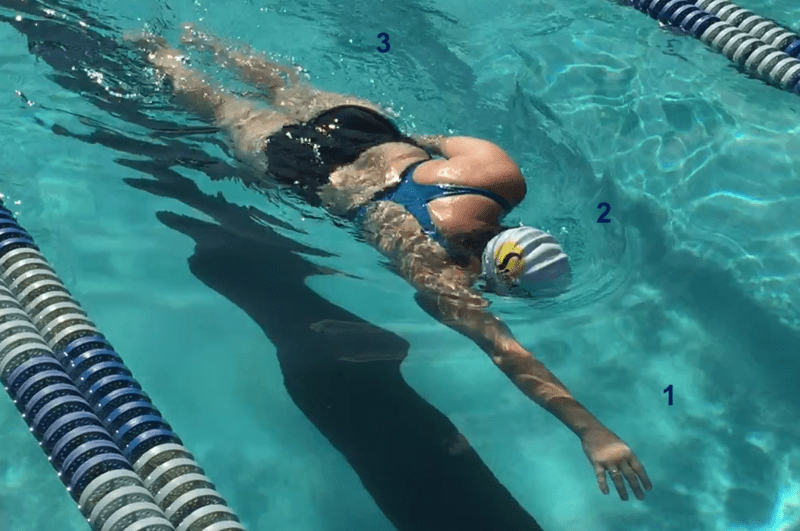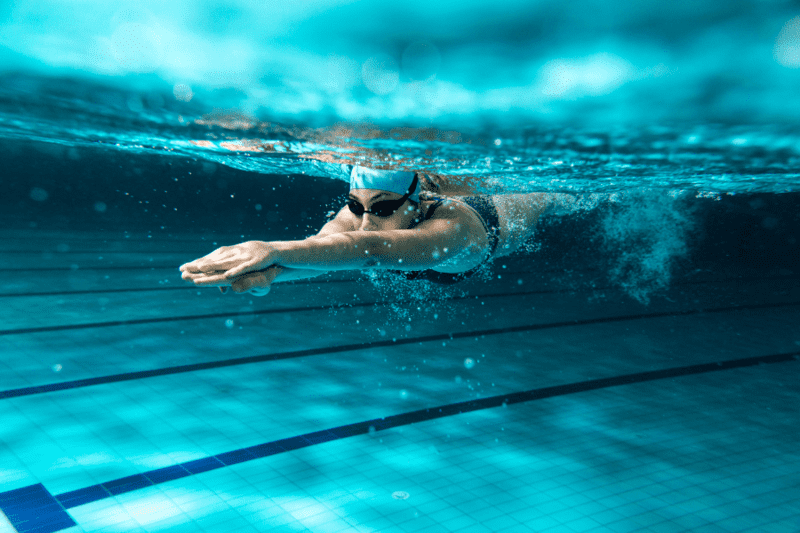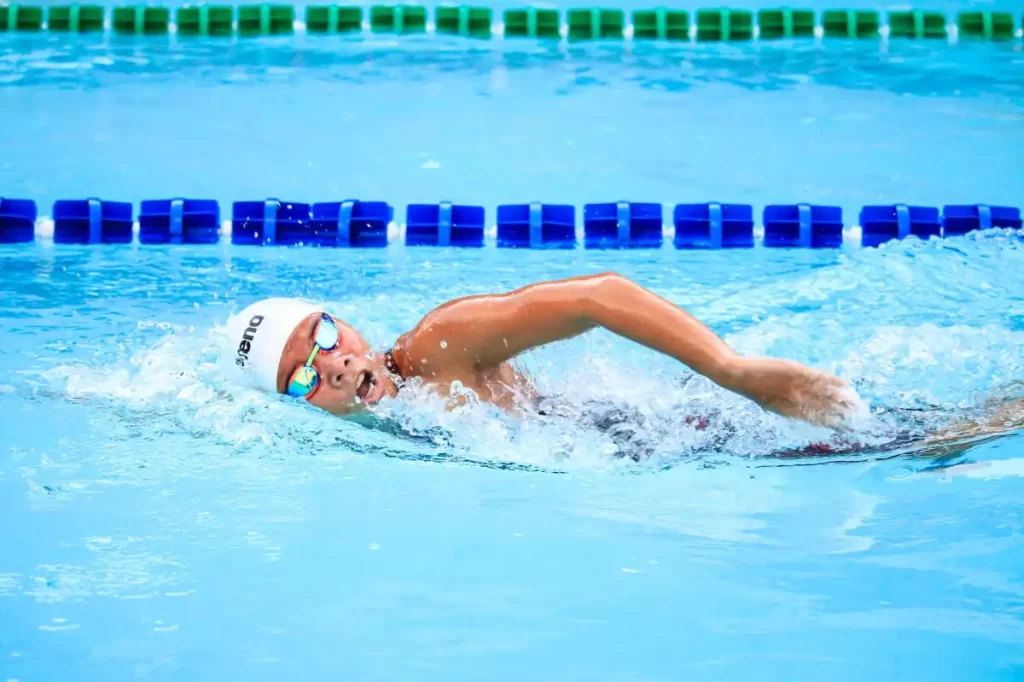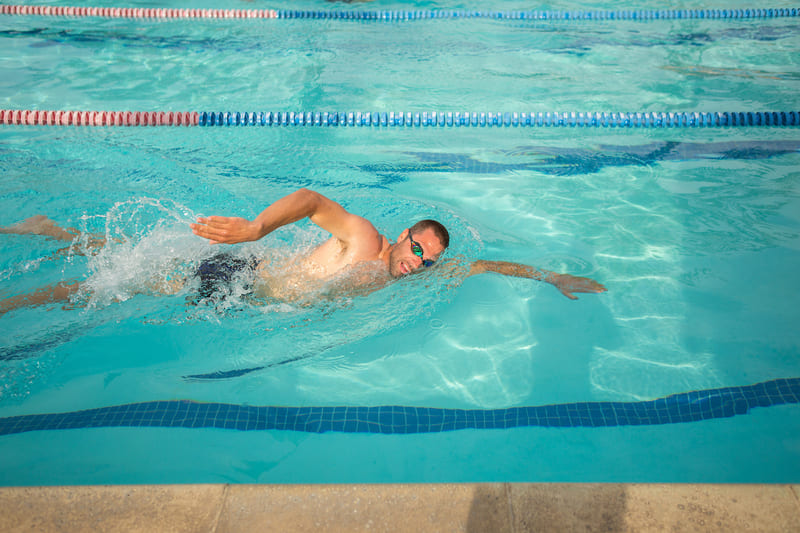Perfecting your freestyle stroke requires more than just logging miles in the pool. It’s about honing your technique, finding balance in the water, and mastering the fundamentals that make for efficient and powerful swimming. In this article, ‘Transform Your Stroke: Top Swim Drills for Freestyle Mastery,’ we’ll dive into a variety of drills designed to sharpen your freestyle technique, improve your breathing and balance, and solidify the core principles of this popular swimming style. We’ll also gain insights from seasoned swimmers and learn how to integrate these drills into your routine for maximum impact.
Key Takeaways
- Combining freestyle and backstroke in drills can teach swimmers to maintain a relaxed rotation and proper body alignment while breathing.
- Practicing breathing every three strokes helps to build symmetry and balance, which are essential for efficient freestyle swimming.
- Focusing on drills like the Early Vertical Forearm (EVF) and High Elbow Catch can significantly improve stroke efficiency and power.
- Seasoned swimmers emphasize the importance of technique, volume, and consistency, as well as the value of learning from other strokes like backstroke.
- Integrating specific freestyle drills into your training, like the Position-11 Triple Switch and vertical kicking, can lead to breakthroughs in your stroke mastery.
Dive into Drills: Sharpening Your Freestyle Technique
Combination Drill: Freestyle Meets Backstroke
The Combination Drill is a game-changer for those looking to refine their freestyle swimming steps. By alternating between freestyle and backstroke, this drill emphasizes the importance of staying relaxed while rotating for air, ensuring a smooth transition and maintaining a horizontal bodyline.

This drill is not just about the movement; it’s about the rhythm and the flow of your strokes as you switch from one style to another.
Here’s how to execute the Combination Drill effectively:
- Start with a single arm freestyle, focusing on a relaxed rotation.
- As you roll to your back, look up and ensure you’re extending fully.
- Practice rolling to air and maintaining a streamlined position.
Incorporating this drill into your routine can significantly improve your breathing, a critical aspect highlighted in the snippet about effective breathing in freestyle. Remember, the key is to stay calm and find your flow in the water.
Catch-Up Drill: Timing and Coordination
The Catch-Up Drill is a classic that’s all about nailing your timing and coordination. It’s a simple concept: one arm waits for the other to ‘catch up’ before starting its stroke. This drill forces you to focus on one arm at a time, which can help correct asymmetries and promote a more balanced stroke.
Here’s how to do it:
- Start with one arm extended out in front, the other at your side.
- Begin your stroke with the extended arm.
- As you pull through, keep the other arm still.
- Once the moving arm is back at your side, the other arm begins its stroke.
This drill is a fantastic way to ensure each arm is pulling its weight, literally. It encourages a patient lead arm and helps you to maintain a steady, uninterrupted rhythm.
Remember to keep your movements smooth and avoid rushing. The goal is to develop a feel for the water and a sense of how your arms can work together seamlessly. Check out Swim Time Log for more tips on drills and swimming techniques.
Read more: 5 Essential Drills to Enhance Your Freestyle Swimming Technique
Fist Drill: Feel the Water, Not the Pace
The Fist Drill is a game-changer for those starting with freestyle drills for beginners. It’s not about how fast you can go; it’s about mastering the feel of the water. By balling your hands into fists, you reduce the surface area and force your forearms to work harder, enhancing your propulsion when you return to a normal hand position.
Here’s how to incorporate the Fist Drill into your routine:
- Swim a length of the pool with fists clenched.
- Focus on keeping your arms straight and your wrists firm.
- Feel the water pressure against your forearms and visualize pushing the water back.
- After a length, swim normally and notice the increased power in your stroke.
This drill is particularly effective for improving your catch phase, where many swimmers tend to break their wrist, losing power and efficiency. Technique: it’s all about form, not pace! Drills for breathing in freestyle can also benefit from the Fist Drill, as it encourages a more balanced and streamlined body position.
The Fist Drill is a tactile way to become more attuned to the water and refine your freestyle technique. It’s not just about moving through the water, but moving the water effectively with each stroke.
Breathing and Balance: The Core of Effortless Swimming
Breathe Every 3: Building Symmetry in the Water
Mastering how to breathe in freestyle swim is not just about gasping for air; it’s about creating a rhythm that complements your stroke. Breathing every three strokes, also known as bilateral breathing, is a technique that promotes balance and symmetry in the water. This pattern ensures that you’re not favoring one side over the other, which can lead to muscle imbalances and a lopsided stroke.
When you breathe every three strokes, you alternate the side you turn your head to for air. This not only helps in building symmetry but also gives you a more even view of the pool, which can be especially useful in open water scenarios.
Here’s a simple breakdown of the breathing pattern:
- :08 – breathe to the right
- :12 – breathe to the left
- :17 – right
- :21 – left
By consistently practicing this drill, you’ll develop a natural feel for the water and an efficient freestyle technique. Remember, the goal is to keep your head movement smooth and integrated with your body rotation, minimizing drag and maintaining a streamlined position.
Position-11 Triple Switch: Finding Your Swimming Rhythm
The Position-11 Triple Switch is all about syncing your body and stroke for a rhythmic freestyle. Think of it as a dance in the water, where each movement is a beat that propels you forward. Here’s how to nail it:

- Start in the ‘Position 11’, with both arms extended forward, parallel to each other.
- Initiate the stroke with one arm, while the other remains extended.
- As you pull through the water, switch arms at the back of the stroke, returning to ‘Position 11’.
This drill encourages a continuous, flowing motion, reducing drag and improving your overall efficiency. It’s a fantastic way to fine-tune your timing and develop that sweet spot in your stroke. Remember, it’s not about strength, but how seamlessly you can transition from one arm to the other.
The key is to maintain a steady, uninterrupted rhythm that feels almost meditative. Let your body guide you and trust the process.
By practicing this drill, you’ll also enhance your breathing technique. Timing your breath with the switch not only keeps you balanced but also ensures you’re not breathing too late, which is a common hiccup for many swimmers. So, dive into the rhythm and let the Position-11 Triple Switch smooth out your freestyle!
Flutter from the Hips: Perfecting the Kick
The flutter kick is a fundamental component of a strong freestyle stroke, and mastering it from the hips is crucial for maintaining balance and propulsion. A strong downward kick will shift the same-side hip up, creating the rolling rhythm essential for efficient swimming. Here’s how to refine your flutter kick:
- Start with a balanced body position, ensuring your thighs are near the surface but not breaking it.
- Practice kicking with fins and a snorkel to develop stability and increase surface area for a more effective kick.
- Use a kickboard in position 11 to maintain proper posture and alignment.
- Gradually remove the board and maintain balance while side kicking.
By focusing on a narrow and quick kick, you’ll foster a quick core rotation that translates into a powerful freestyle stroke.
Remember, the flutter kick isn’t just about the legs; it’s about integrating the kick into your entire body movement. Playing with the height of your kick and using tools like pull buoys can help you understand the dynamics of your kick and how it affects your overall stroke.
From Basics to Brilliance: Mastering Freestyle Fundamentals
Early Vertical Forearm (EVF): The Key to Efficient Strokes
Mastering the Early Vertical Forearm (EVF) is like unlocking a new level in your swimming game. It’s all about getting your forearm vertical early in the stroke, which sets you up for a powerful pull through the water. Think of it as your hand and forearm teaming up to create a paddle, propelling you forward with each stroke.
To get the hang of EVF, start with sculling drills. These help you feel the water and teach your muscles the right movement pattern. Here’s a simple progression to follow:
- Begin with front scull, focusing on keeping your elbows high and in front of your shoulders.
- Move your elbows to shoulder depth, ensuring your palms face back and your fingers point down.
- Stabilize your upper arm and practice isolating the movement to just your forearm.
By isolating the upper arm and focusing on the forearm position, you’re engaging the larger muscles in your back, which leads to a more effective pull.
Remember, it’s not just about moving your arms; it’s about engaging the right muscles and building the coordination to use them effectively. Practice these drills regularly, and you’ll start to feel the difference in your stroke efficiency.
High Elbow Catch: The Secret to Powerful Pulls
Unlocking the power of your freestyle comes down to mastering the high elbow catch. This technique is all about keeping your elbow high during the underwater pull, which allows you to engage the larger muscles in your back, giving you a stronger and more efficient stroke. Here’s a simple breakdown to get you started:
- Position your elbow: Aim to have a high elbow position as you initiate the pull.
- Straight arm: Even with a high elbow, ensure you’re using your entire arm to create a large surface area.
- Engage your muscles: Focus on using your back muscles to drive the pull.
By consistently practicing the high elbow catch, you’ll develop a feel for the water that translates into more powerful pulls.
Remember, it’s not just about moving your arms through the water; it’s about creating a connection with the water that propels you forward. Practice doing this exercise with one arm moving, then with both. The key is to give yourself a little pause to memorize the position and ensure your wrist stays straight throughout.
Vertical Kicking: A Surprising Approach to Freestyle Mastery
Vertical kicking turns traditional freestyle kick drills on their head, quite literally. Instead of propelling yourself across the pool, you’ll be aiming to stay afloat in an upright position. This drill is a simple trick that will transform your swim kick, honing in on the power and consistency needed for a strong freestyle kick.

Here’s how to get started with vertical kicking:
- Find a depth where you can’t touch the bottom.
- Keep your hands out of the water to avoid assistance.
- Begin with short intervals, focusing on maintaining a narrow and consistent kick.
- Gradually increase the duration as your kick becomes more powerful.
Vertical kicking is not just for advanced swimmers; it’s a valuable tool for freestyle for beginners as well. It isolates the legs, allowing swimmers to concentrate on the flutter kick’s mechanics without the complexity of full strokes.
By integrating vertical kicking into your routine, you’ll develop a kick that’s not only effective but also sustainable over long distances. It’s a step that can’t be overlooked if you’re serious about mastering freestyle swimming.
Beyond the Pool: Insights from Seasoned Swimmers
Stories of Swimmers Pushing Their Limits
The journey from novice to master in the pool is filled with personal victories and challenges that often go unseen. Every swimmer has a story, a unique narrative of overcoming obstacles and achieving goals that seemed insurmountable. Take Brian’s story, for example, featured on MySwimPro. Once a smoker, he transformed his life through swimming, becoming a beacon of inspiration for many. His dedication reminds us that it’s not just about the laps we swim, but the resilience we build along the way.
The water is a great equalizer; it doesn’t care about your past, only your effort and determination in the present moment.
Swimmers like Brian show us that the pool is more than a place for physical training; it’s a crucible for personal growth. From the initial plunge into the water to the relentless pursuit of better technique and faster times, these stories highlight the sheer willpower and tenacity required to excel in freestyle swimming.
Lessons and Realizations from Decades of Swimming
Swimming is a journey, not just a set of techniques. Seasoned swimmers often share that the most profound lessons come from the process itself, not just the end results. Over time, they’ve learned the importance of consistency, the need for adaptability, and the value of patience.
- Consistency is key to progress. It’s not about one great workout, but the accumulation of many good ones.
- Adaptability is crucial. Conditions change, and so must your approach.
- Patience is a virtue. Mastery doesn’t happen overnight.
The real transformation in swimming comes from the commitment to the sport and the willingness to embrace the learning curve. It’s about building water confidence, understanding your own body, and ultimately, finding joy in every stroke.
Whether it’s the ‘aha’ moments that come with perfecting a technique or the camaraderie found in training with a squad, the experiences gained from swimming are as diverse as they are enriching. The journey from beginner’s trepidation to the confidence of a seasoned athlete is filled with personal victories and the occasional battle with jellyfish or sea lice.
Developing the Next Generation of Freestyle Champions
As we look to the future of freestyle swimming, it’s crucial to pass on the baton of knowledge to the young enthusiasts eager to make a splash. Freestyle swimming tips for beginners are the foundation upon which new champions are built. It’s not just about the strokes; it’s about instilling confidence and a love for the sport.

For those just starting out, understanding the swimming freestyle technique for beginners is essential. It’s about more than just moving through the water; it’s about learning the right movements from the get-go to avoid forming bad habits. Here’s a simple list to get the youngsters on the right track:
- Start with the basics: body alignment and breathing.
- Focus on the kick in freestyle swimming; it’s the engine that drives the stroke.
- Emulate champions like Michael Phelps freestyle; watch and learn from the best.
By nurturing these young swimmers with the right techniques and mindset, we’re not just teaching them how to swim; we’re teaching them how to excel and enjoy every lap.
Remember, every champion was once a beginner. With patience and practice, today’s learners can become tomorrow’s legends.
Training Smart: Integrating Drills into Your Swim Routine
Triathletes and Freestyle: A Symbiotic Relationship
For triathletes, freestyle swimming isn’t just one discipline among three; it’s a critical skill that can set the tone for the entire race. Mastering freestyle is about more than just speed; it’s about efficiency and endurance. Triathletes often find that improvements in the water have a ripple effect, enhancing their performance in cycling and running as well.
- Practice makes perfect, and for triathletes, this means a lot of time in the pool. Freestyle drills are not just about logging meters; they’re about perfecting form and building muscle memory.
- Incorporating a variety of workouts is key. Longer intervals can help build speed, while drills like the high elbow catch and vertical kicking reinforce technique.
- Consistency is crucial. Regular swim sessions ensure that technique stays sharp and stamina continues to build.
In the world of triathlon, freestyle swimming is the great equalizer. It’s where races can be won or lost, and where the foundation for a strong finish is laid.
Combining Technique with Volume: The Path to Endurance
When it comes to building endurance in the pool, it’s not just about clocking miles. It’s about integrating technique-focused drills into those longer sessions. By combining high-volume swims with technical precision, you create a powerful synergy that propels your freestyle forward.
For instance, consider a workout structure that begins with a warm-up, transitions into a set of technique drills, and culminates in a longer, steady-state swim. This approach ensures that even as fatigue sets in, your form remains sharp, reducing the risk of injury and ingraining good habits.
The key is to maintain a focus on form throughout the endurance workout. It’s easy to let technique slip when the yardage piles up, but that’s when the benefits of your drills can really shine through.
Here’s a sample workout plan to illustrate the concept:
- Warm-up: 400 yards as 100 swim, 100 kick, 100 pull, 100 drill
- Technique set: Choose drills that target your weaknesses
- Main set: A longer swim where you focus on applying the techniques you’ve just practiced
Remember, the goal is to merge the stamina you’re building with the skills you’ve honed. This balanced approach can lead to significant improvements in your freestyle endurance and overall performance.
Making Every Stroke Count: Quality Over Quantity
In the quest for freestyle mastery, it’s easy to get caught up in the numbers game—counting laps, tracking times, and obsessing over distances. But here’s the kicker: not all strokes are created equal. It’s the quality of each stroke that propels you forward, not just the sheer volume of water churned behind you.
To make every stroke count, start by tuning into your body. Are you gliding through the water or fighting against it? Is your pull smooth and strong or are you slipping through your catch? These nuances make a world of difference. Here’s a simple checklist to keep your technique in check:
- Ensure your hand enters the water with precision.
- Focus on maintaining a high elbow during the pull phase.
- Keep your body aligned and streamlined.
- Use a consistent and effective kick.
By honing in on these elements, you’ll find that less can indeed be more. Reducing unnecessary movements and refining your stroke will lead to greater efficiency and speed.
Remember, freestyle swimming is a symphony of movements, and each part of your body plays a crucial role. Pay attention to feedback from coaches or experienced swimmers to refine your technique further. It’s about finding that sweet spot where stroke rate and stroke length work in harmony, leading to that effortless glide every swimmer strives for.
Conclusion
Alright, swim fans, we’ve dived deep into the pool of freestyle drills and surfaced with some game-changing techniques to help you master your stroke. From the finesse of the Combination Drill to the rhythm of the Position-11 Triple Switch, we’ve covered a breadth of exercises that are sure to give your freestyle the edge it needs. Remember, it’s not just about thrashing through the water; it’s about smart, consistent practice and a focus on form. So grab your goggles, hit the pool, and let’s make some waves with these top drills. And hey, don’t forget to share your progress and favorite drills in the comments – we’re all in this swim journey together!
Read more: Perfecting the Stroke: Essential Freestyle Drill Techniques for Swimmers
AUTHOR
Sang Nguyen
Sang Nguyen is a former national swimmer for Vietnam who has transitioned into coaching. With a passion for fostering a healthy swimming community and connecting like-minded individuals,......Read More
BLOG
Maybe You Are Interested
Good Swim Meet Snacks: What to Eat for Optimal Performance
Good nutrition is crucial for swimmers to maintain energy, recover quickly, and perform at their...
Read More...Optimizing Your Performance: The Best Diet for Swimming Training
Optimizing your performance in swimming is not just about rigorous training; it’s equally crucial to...
Read More...Achieve Peak Performance with This Diet Chart for Swimmers
Whether you’re a novice or an expert swimmer, understanding the right diet is crucial for...
Read More...Eating Like a Champion: Exploring the Diet of Michael Phelps
Michael Phelps, renowned for his Olympic triumphs, has a diet as extraordinary as his swimming...
Read More...Muscle Gain for Swimmers: Tailoring Your Diet for Strength
Swimming is a demanding sport that requires a tailored approach to nutrition to support muscle...
Read More...A Comprehensive Diet Plan To Gain Weight For Swimmers
Swimming is a demanding sport that requires meticulous attention to nutritional needs to optimize performance,...
Read More...